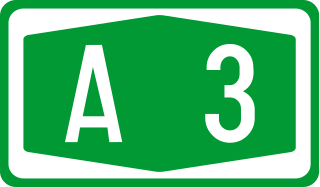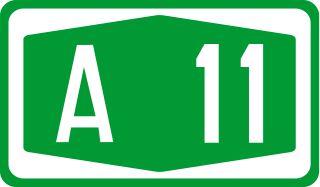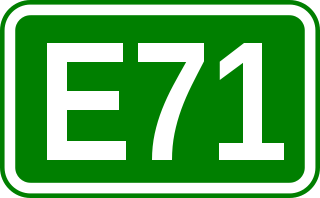| Zrinski Bridge / Zrinyi Bridge | |
|---|---|
| Coordinates | 46°24′44″N16°42′04″E / 46.41215°N 16.701021°E Coordinates: 46°24′44″N16°42′04″E / 46.41215°N 16.701021°E |
| Carries | road vehicles |
| Crosses | Mura River |
| Locale | Northern Croatia, southwest Hungary |
| Official name | Zrinski most / Zrínyi híd |
| Maintained by | Hrvatske autoceste Állami Autópálya Kezelő Zrt. |
| Characteristics | |
| Design | Box girder bridge |
| Total length | 216 m (709 ft) |
| Width | 2 × 15 m (49 ft) |
| Longest span | 48 m (157 ft) |
| History | |
| Opened | 2008 |
| Statistics | |
| Toll | not tolled |
The Zrinski Bridge or Zrínyi Bridge (Croatian : Zrinski most, Hungarian : Zrínyi híd) connects the Croatian A4 and the Hungarian M7 motorways, spanning the Mura River. As it also spans Hungarian–Croatian border, a joint border checkpoint is located north of the bridge. The bridge is located between Goričan interchange of the A4 motorway and the M70 motorway interchange of the M7. The bridge is a part of a major north–south transportation corridor in Croatia and Hungary and a part of European routes E65 and E71 as well as the Pan-European corridor Vb.

Croatian is the standardized variety of the Serbo-Croatian language used by Croats, principally in Croatia, Bosnia and Herzegovina, the Serbian province of Vojvodina and other neighboring countries. It is the official and literary standard of Croatia and one of the official languages of the European Union. Croatian is also one of the official languages of Bosnia and Herzegovina and a recognized minority language in Serbia and neighboring countries.

Hungarian is a Finno-Ugric language spoken in Hungary and several neighbouring countries. It is the official language of Hungary and one of the 24 official languages of the European Union. Outside Hungary it is also spoken by communities of Hungarians in the countries that today make up Slovakia, western Ukraine (Subcarpathia), central and western Romania (Transylvania), northern Serbia (Vojvodina), northern Croatia, and northern Slovenia. It is also spoken by Hungarian diaspora communities worldwide, especially in North America and in Israel. Like Finnish and Estonian, Hungarian belongs to the Uralic language family. With 13 million speakers, it is its largest member in terms of speakers.

The A4 motorway is a motorway in Croatia spanning 97.0 kilometres (60.3 mi). It connects the nation's capital, Zagreb, to the city of Varaždin and to Budapest, Hungary via the Goričan border crossing. The motorway represents a major north–south transportation corridor in Croatia and is a part of European routes E65 and E71. The A4 motorway route also follows Pan-European corridor Vb.
Contents
The bridge is a composite continuous girder structure executed across five spans, 216 meters (709 feet) long overall. It consists of two 15-meter (49 ft) parallel structures, each carrying one carriageway, set 80 centimeters (31 inches) apart. Construction and naming of the bridge was announced in 2007 by Croatian and Hungarian governments following a joint session, and ceremonially opened on 22 October 2008 as the last piece of the motorway route connecting the Hungarian capital, Budapest, to the Croatian capital, Zagreb, and the Port of Rijeka after 40 years of construction.

Budapest is the capital and the most populous city of Hungary, and the tenth-largest city in the European Union by population within city limits. The city had an estimated population of 1,752,704 in 2016 distributed over a land area of about 525 square kilometres. Budapest is both a city and county, and forms the centre of the Budapest metropolitan area, which has an area of 7,626 square kilometres and a population of 3,303,786, comprising 33 percent of the population of Hungary.

Zagreb is the capital and the largest city of Croatia. It is located in the northwest of the country, along the Sava river, at the southern slopes of the Medvednica mountain. Zagreb lies at an elevation of approximately 122 m (400 ft) above sea level. The estimated population of the city in 2018 is 810,003. The population of the Zagreb urban agglomeration is about 1.1 million, approximately a quarter of the total population of Croatia.
The Port of Rijeka is a seaport in Rijeka, Croatia, located on the shore of the Kvarner Gulf in the Adriatic Sea. The first records of the port date to 1281. It was the main port of the Kingdom of Hungary in the 19th century and the beginning of the 20th century, of Yugoslavia between World War II and 1991, and of Croatia after its independence. Today, it is the largest port in Croatia with a cargo throughput of 11.2 million tonnes (2016), mostly oil, general cargo and bulk cargo, and 214,348 Twenty-foot equivalent units (TEUs).
The bridge was designed by Uvaterv and built by Hidroelektra-Niskogradnja at a cost of 8 million kuna (1.08 million euro). The cost was shared equally by Croatia and Hungary. The bridge is maintained by Hrvatske autoceste and Állami Autópálya Kezelő Zrt.

The kuna is the currency of Croatia, in use since 1994. It is subdivided into 100 lipa. The kuna is issued by the Croatian National Bank and the coins are minted by the Croatian Monetary Institute.
Hrvatske autoceste (HAC) or Croatian Motorways Ltd is a Croatian state-owned limited liability company tasked with management, construction and maintenance of motorways in Croatia pursuant to provisions of the Croatian Public Roads Act (Croatian: Zakon o javnim cestama enacted by the Parliament of the Republic of Croatia. Tasks of the company are defined by Public Roads Act and its Founding Declaration, and the principal task of the company is management, construction and maintenance of the motorways. In practice, Hrvatske autoceste is responsible for management or development the following motorway sections:

















